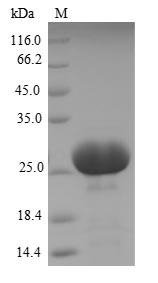Amino acids 35-155 form the expressed segment for recombinant Human CEACAM3. The calculated molecular weight for this CEACAM3 protein is 29.1 kDa. This CEACAM3 recombinant protein is manufactured in e.coli. The N-terminal 6xHis-SUMO tag was fused into the coding gene segment of CEACAM3, making it easier to detect and purify the CEACAM3 recombinant protein in the later stages of expression and purification.
Carcinoembryonic antigen-related cell adhesion molecule 3 (CEACAM3) is a protein that takes the spotlight in immunology and infectious disease research. Its primary role lies in the immune system, particularly in the host-pathogen interactions. CEACAM3 is featured in studies exploring the mechanisms of bacterial infections, notably its involvement in the recognition and phagocytosis of bacteria by immune cells, especially neutrophils. In infectious disease research, CEACAM3 works as a receptor for specific pathogens, facilitating their uptake and destruction by immune cells. This makes CEACAM3 a key player in our understanding of how the immune system combats bacterial infections. Additionally, CEACAM3 is implicated in broader areas of immunology, contributing to the understanding of innate immune responses. Its involvement in modulating inflammatory reactions and influencing immune cell behavior broadens its significance in the overall immune system function.




